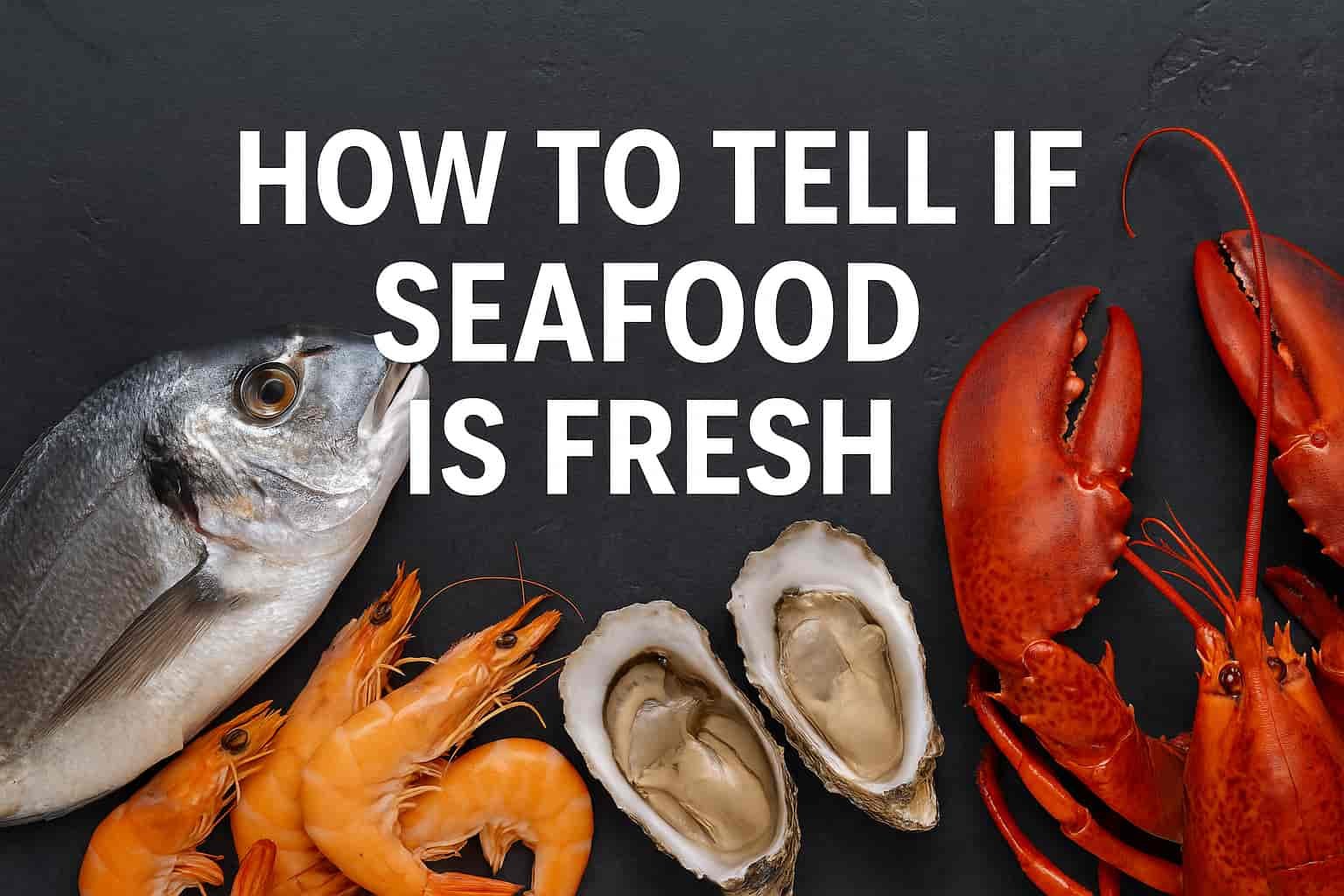Are you confident that the seafood you buy is truly fresh? Whether you’re a passionate home cook or someone who enjoys a simple seafood meal, knowing how to tell if seafood is fresh is a critical skill. Fresh seafood isn’t just about taste—it directly impacts your health and ensures you get the full nutritional benefits seafood offers. Consuming seafood past its prime can expose you to harmful bacteria like Vibrio and Listeria, leading to foodborne illnesses that are entirely preventable with the right knowledge.
In this guide, you’ll learn how to visually assess seafood, detect freshness through smell, and avoid common purchasing mistakes. From evaluating the clear brightness of a fish’s eyes to checking the firmness of shrimp shells, every method here is actionable and practical. The next time you visit a market or grocery store, you’ll be able to confidently select the freshest options and enjoy seafood at its peak quality.
Contents
- 1 What Are the Most Reliable Signs of Fresh Fish at the Market?
- 2 How Do You Evaluate the Freshness of Shellfish Like Oysters, Mussels, and Clams?
- 3 What Are the Indicators of Freshness for Shrimp and Prawns?
- 4 How Can You Assess the Freshness of Frozen Seafood?
- 5 How Long Does Seafood Stay Fresh After Purchase Without Freezing?
- 6 What Are Common Myths About Seafood Freshness You Should Ignore?
- 7 How Can You Ensure the Seafood You Buy Is Always Fresh?
What Are the Most Reliable Signs of Fresh Fish at the Market?
Fresh fish show clear, undeniable visual and sensory signs. When evaluating whole fish, start with the eyes. Fresh fish eyes should be clear, bright, and slightly bulging. Sunken, cloudy, or dull eyes are reliable indicators that the fish is no longer fresh.
Next, examine the gills. Lift the gill cover and check for a rich, vibrant red color. Fresh gills are moist and free of slime. If the gills appear brown or faded and have a sticky texture, the fish is past its optimal freshness.
The skin and scales should appear shiny and metallic, tightly attached to the flesh. If scales come off easily or the skin looks dull, the fish has likely been sitting out too long. Also, press your finger gently into the flesh—fresh fish should spring back immediately. If an indentation remains, it’s a clear sign of deterioration.
Finally, trust your nose. Fresh fish should have a mild, ocean-like scent, not an overpowering fishy or sour odor. An ammonia-like smell is a direct indicator of spoilage.
How Do You Evaluate the Freshness of Shellfish Like Oysters, Mussels, and Clams?
For live shellfish, the first rule is simple: shells must be tightly closed. If the shells are slightly open, give them a gentle tap. Fresh, live shellfish will react by closing their shells. If they remain open, the shellfish is dead and unsafe to eat.
Smell also plays a critical role. Fresh shellfish should smell like the ocean breeze—clean and briny. A strong, sour, or rotting odor means the shellfish has spoiled.
Check the shell condition as well. Cracked or broken shells indicate damage and possible contamination. Healthy shellfish have hard, intact shells that feel heavy for their size. If a shell feels unusually light, it may be dried out and unsafe for consumption.
When buying shucked oysters or clams, inspect the liquid they’re stored in. It should be clear and odorless, not milky or cloudy. Cloudy liquid suggests bacterial growth and poor handling practices.
What Are the Indicators of Freshness for Shrimp and Prawns?
Fresh shrimp and prawns offer specific visual and olfactory clues. Their shell color should be translucent and glossy, with no black spots or discoloration. Black spots often indicate enzymatic breakdown, a clear sign of aging shrimp.
Inspect the texture of the shells. Fresh shrimp should have firm, crisp shells that snap slightly when bent. If the shells feel soft or mushy, the shrimp is deteriorating.
The smell test is just as important. Fresh shrimp should have a mild, seawater scent. If you detect a strong ammonia-like smell, this is a chemical byproduct of spoilage and indicates the shrimp is unsafe to eat.
Lastly, pay attention to the shape of the body. Fresh shrimp are naturally curved. If the shrimp appear limp and stretched straight, it’s often a sign they’ve been thawed and refrozen multiple times, compromising their quality.
How Can You Assess the Freshness of Frozen Seafood?
Frozen seafood requires a different evaluation approach since visual and olfactory indicators are affected by the freezing process. Start by examining the packaging. It should be airtight, undamaged, and free of excessive frost. Packages with torn seals or ice accumulation suggest improper storage or repeated thawing and refreezing, which significantly reduces seafood quality.
Look closely for ice crystals. A thin, even layer of frost is acceptable, but large ice crystals or frost burn indicate the seafood has been stored too long or at fluctuating temperatures. These crystals cause moisture loss, leading to dry, flavorless seafood upon cooking.
The color of frozen seafood is another important clue. Fish fillets should retain a natural, vibrant color. If you notice dullness, discoloration, or grayish patches, it’s a sign of oxidation and poor preservation. For shellfish like shrimp or scallops, the flesh should remain firm and slightly translucent, not opaque or spongy.
Always check the expiration date and, if possible, the packaging date. Seafood frozen at peak freshness and consumed within the recommended period maintains better texture and flavor after cooking.
How Long Does Seafood Stay Fresh After Purchase Without Freezing?
Seafood is highly perishable and requires careful handling. At room temperature, seafood can spoil in as little as two hours, or even faster in hot and humid environments. Bacteria multiply rapidly between 40°F (4°C) and 140°F (60°C), which is known as the danger zone for food safety.
When stored in the refrigerator, fresh seafood remains safe to consume for 1 to 2 days. Always store seafood at or below 32°F (0°C) for optimal freshness. Placing it on a bed of ice in a shallow pan helps maintain a consistent cold temperature.
It’s critical to store seafood in sealed containers or tightly wrapped in plastic to prevent cross-contamination and exposure to air, which accelerates spoilage. If you don’t plan to consume seafood within 48 hours, freezing is the safest option to preserve quality. For detailed methods, check our guide on How to Store Fresh Seafood Properly.
What Are Common Myths About Seafood Freshness You Should Ignore?
One widespread myth is that “clear eyes always mean fresh fish.” While clear eyes are a good indicator, some fish species naturally have cloudy eyes even when freshly caught. Relying solely on eye clarity without checking the gills, skin, and smell can lead to false assumptions.
Another common belief is that “if it smells like the ocean, it’s fresh.” In reality, even spoiled seafood may retain a salty scent, masking underlying spoilage odors. A more reliable method is to check for any ammonia-like or sour smells, which definitively indicate decomposition.
Lastly, many believe that frozen seafood is lower quality than fresh seafood. In fact, seafood that’s flash-frozen immediately after harvest often retains better texture and nutritional value than “fresh” seafood that has spent days in transit and display.
How Can You Ensure the Seafood You Buy Is Always Fresh?
Buying fresh seafood consistently requires a proactive approach. Start by choosing reputable suppliers. Fish markets and grocery stores with a high turnover rate typically have fresher stock since their products sell quickly. Don’t hesitate to ask the staff when the seafood was delivered and whether it’s been previously frozen.
Arrive at the market early in the day. This is when the freshest catches are usually displayed before being picked over by other shoppers. For live seafood like oysters and clams, check that tanks are clean and well-aerated, as dirty tanks often indicate poor handling practices.
Use a mental freshness checklist:
- Are the fish eyes clear and the gills bright red?
- Does the seafood smell clean and mild, not sour or ammonia-like?
- Are the shells of clams and mussels tightly closed?
If the seafood doesn’t meet these criteria, it’s best to walk away. Remember, never compromise on freshness—poor quality seafood can lead to unpleasant dining experiences and health risks.



